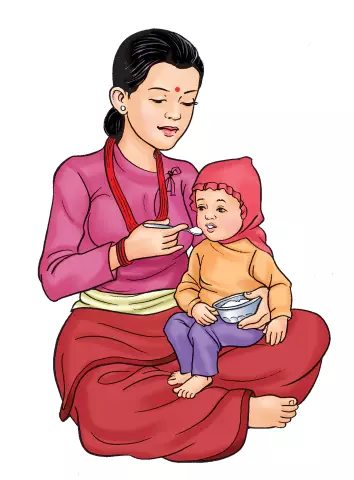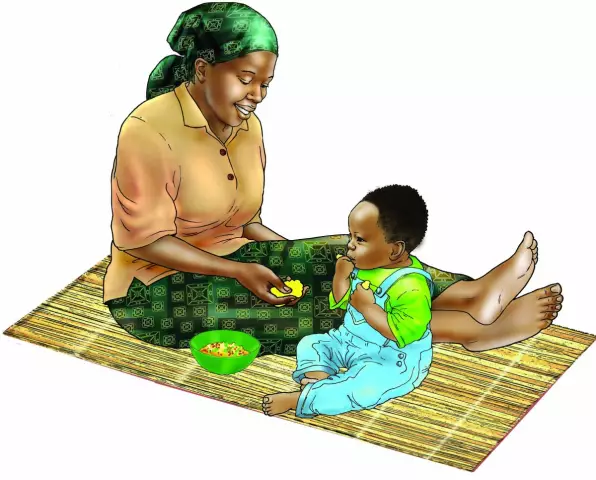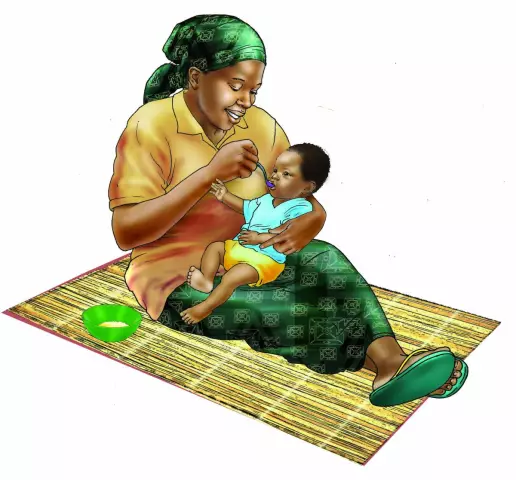- Author Rachel Wainwright [email protected].
- Public 2023-12-15 07:39.
- Last modified 2025-11-02 20:14.
Complementary feeding of the child by months
Many mothers are worried about the question, from how many months the child can be given complementary foods, what it should be and in what quantity. It is very important that complementary foods for the baby consist of healthy, wholesome and fresh food, since the taste preferences of the baby in the future will depend on what the baby will eat up to one year old.

Of course, the best food for a child is breast milk, which contains all the vitamins and macronutrients necessary for the development of the baby, and in cases where breastfeeding is impossible, adapted milk formulas are substituted.
By 5-6 months, when the baby's first teeth begin to appear, breast milk or an adapted milk formula is no longer enough for the baby, as he actively learns the world, gradually begins to sit, then crawl and walk, which, of course, requires a lot of energy, and accordingly, more calories should enter the body. By the way, it is the appearance of the first teeth that indicates that the child's body is ready to introduce complementary foods, and the child's interest in food also speaks of this.
On average, the first complementary foods for babies who were breastfed become necessary at 6 months, and babies who are bottle-fed from birth are ready for complementary foods from 5-5.5 months. So, having determined from how many months the child can begin to introduce complementary foods, it is necessary to decide on the food that is suitable for this role.
As the very first complementary food, a piece of an apple or pear peeled and core, a spoonful of buckwheat porridge cooked in water or a spoonful of mashed potatoes are perfect. Choosing, for example, a slice of apple, it is necessary to give the baby a slice of apple every day before breastfeeding for 3 days. If the baby does not show signs of non-acceptance of such food, you can proceed to the next type of complementary foods. This method of introducing new food into the baby's diet is called pedagogical complementary foods, since its task is not to feed the child, but to introduce him to the variety of adult food.
Complementary feeding of an infant by months should be varied, however, mothers should not introduce several new products into the child's diet at once, because in the event of a negative reaction to some product, it will be difficult to establish what exactly did not suit the child and caused a negative reaction.
Complementary feeding of the child by months: practical advice for mothers
So, having decided to introduce complementary foods into the child's diet, mothers should not rush to transfer the baby to a common table, since not all food that adults eat is suitable even as a pedagogical complementary food. The fact is that the child's digestive system is not yet able to digest fried, salty, fatty or smoked food until a year old, as well as a variety of sweets, raw vegetables, semi-finished products and meat products (sausages, sausages).
Mom should let her baby decide when to finish eating. It is strictly forbidden to shove and force the baby to finish complementary foods to the end, because this will lead to problems with food in the child in the future.
It is best to give a baby's feeding for months in the first half of the day in small portions - half a teaspoon for the first time will be enough. If the child's reaction to the new food is positive, then the next day it will be possible to give a whole spoonful and so on.
Signs that the eaten complementary food is not suitable for the child will be rashes and redness on the skin, as well as pain in the tummy. If such negative symptoms are observed, then it is better not to introduce any new complementary foods into the baby's diet for at least 3 days, and completely abandon the product that caused the problem.
By the time a gradual increase in the amount of complementary foods introduced by a child by months to a year reaches the size of one meal, you can introduce drinking water and tea into the child's diet, which can be offered to the baby during and between meals.
Complementary feeding of an infant by months: menu
So, the child has already grown to the age of 6 months, the mother decided to start introducing complementary foods into his diet. The first complementary food may consist of cereals or vegetable purees. Porridge (buckwheat, corn or rice) must be pre-chopped in a blender or coffee grinder, it must be boiled in water. Vegetable puree can be squash, cauliflower or potato, it, like porridge, must be chopped in a blender. The first portions of complementary foods should not exceed a volume of 100-150 g. Complementary foods for a child by months to a year will become more and more diverse, the mother should not only introduce the baby to new food, but also with the rules of behavior at the table - to teach at first how to hold a spoon and scoop food from the plate with it, and when the baby has already learned to walk, it will be possible to introduce him to the fork.
Approximately the complementary feeding of the child for months to a year is as follows:
- 6 months - apples, pears, cereals (rice, buckwheat and corn) and vegetable puree from one ingredient (potato, pumpkin, squash, cauliflower, broccoli or spinach) allergic reactions;
- 7 months - vegetable puree from several ingredients, vegetable soups, a quarter of an egg yolk twice a week;
- 8 months - fermented milk drinks, 100 ml per day (yoghurts and kefirs without additives), cottage cheese, fruit puree from peach, apple or pear;
- 9 months - meat (beef, turkey or rabbit);
- 10 months - 50 g of low-fat fish per day (sea bass, cod or hake), berry puree and baby cookies;
- 11 months - beets, carrots (you can cook borscht), fresh herbs, sour cream, bread with butter, porridge (semolina, pearl barley, oatmeal, barley and wheat), steamed cutlets and meatballs;
- 12 months - freshly squeezed fruit juice, cow's milk and celery.
Complementary feeding of the baby by months: how to properly prepare food for the baby

So, having decided on what can be used and at what age as complementary foods for a baby, mothers should know that all products must be of high quality. Cooking food that serves as a baby's food for months can only be steamed or boiled. Those who have a steamer or multicooker at home are in an advantageous position, since the food cooked in these kitchen appliances has a richer taste and delicate texture, and according to nutritionists, this cooking method preserves vitamins better. It is strictly forbidden to fry food for the baby, even dressing for borscht.
At the age of one year, the mother's task is to accustom the child to the natural taste of products, so it is better not to add sugar or salt to them, and sour compotes and jelly can be sweetened with honey or grape sugar.
Since at the time of the introduction of complementary foods, only 1-2 teeth erupt in a child for months, the food must accordingly be rubbed, because he still has nothing special to chew on. By 8-9 months, food can simply be kneaded with a fork to a puree state, and by the year the food can already be cut into 2 cm pieces.
YouTube video related to the article:
Found a mistake in the text? Select it and press Ctrl + Enter.






